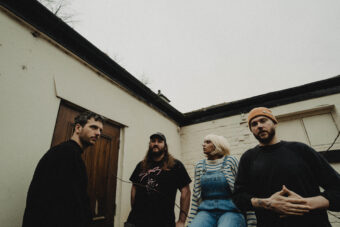By the time most of Mark Linkous’ fans had heard of him, he was in his mid-30s and had already started over. The Virginia native had moved to New York and then Los Angeles in the ‘80s, releasing two albums with the Dancing Hoods. He enjoyed a little success on the nascent alternative rock circuit, opening for Camper Van Beethoven and receiving airplay on college radio and MTV’s 120 Minutes. After Dancing Hoods broke up, Linkous returned to Richmond, Virginia, quietly writing songs and cycling through a couple of short-lived projects before settling on Sparklehorse. When Camper Van Beethoven’s David Lowery formed Cracker, he and Linkous co-wrote “Sick of Goodbyes” for Kerosene Hat, their platinum 1993 album. A couple of years later, Sparklehorse released their major-label debut, 1995’s Vivadixiesubmarinetransmissionplot.
After four albums, Sparklehorse was on the verge of releasing a star-studded album/photobook collaboration with Danger Mouse and David Lynch, Dark Night of the Soul, when Linkous died by suicide on March 6, 2010, in Knoxville, Tennessee. The catalog he left behind was idiosyncratic and full of distortion and tape hiss. Most of the material was recorded at his own aptly named studio Static King, first set up in Virginia and later in North Carolina. It’s the uncompromising and strangely beautiful work of a man who’d tried to “make it” in an old fashioned move-to-the-big-city way but subsequently found success on his own terms.
The specter of narrowly avoided tragedy loomed over most of Sparklehorse’s career, even while Linkous was alive. Their only minor U.S. radio hit, “Someday I Will Treat You Good,” made its brief run on the alternative charts in 1996. It came at the same time the band was opening for Radiohead in the U.K., where Sparklehorse would consistently find its greatest commercial success. But then Linkous collapsed in a London hotel room after a bad reaction between his antidepressants and his insomnia medication, injuring his legs in the process. He recovered in St. Mary’s Hospital in London and then spent months confined to a wheelchair. That ordeal became the defining episode that led nearly every review and article written about the band’s next album, 1998’s Good Morning Spider, which featured songs about the experience including “Saint Mary,” and every Sparklehorse album thereafter.
Sparklehorse’s first two albums brimmed over with strange song fragments and abrupt mood shifts – the 33-second “Box of Stars (Part One)” was as dreamily haunting as the 45-second “Ballad of a Cold Lost Marble” was harsh and abrupt. “Chaos of the Galaxy/Happy Man” featured a hooky uptempo song occasionally stabbing through radio static and a funereal organ piece – “Happy Man” was later cleaned up and presented by itself as a single. The lyrics teeming with horses, birds, pigs, dogs, and cows, and recurring references to Captain Howdy – a child’s nickname for the demon possessing her in the 1973 film The Exorcist — as if a horrible evil was cheerfully floating in the background of his bittersweet and often dryly funny songs about life in rural Virginia.
Even if Linkous never became quite as well known as heroes like Neil Young or Tom Waits, he followed their career trajectory by releasing music on big labels that had a defiantly homespun, spontaneous atmosphere and unpolished texture. 2001’s It’s A Wonderful Life took a shrewd step towards a slightly more accessible sound by pairing Linkous with Dave Fridmann, the producer who’d brought great acclaim to other bands with a skewed aesthetic and boyish, Young-like vocals, Flaming Lips and Mercury Rev. Linkous, always more respected by his peers than recognized by the record-buying public, was further welcomed into the more prestigious circles of alternative music by people like PJ Harvey, the Cardigans’ Nina Persson and even Waits himself, both of whom guested on It’s A Wonderful Life.
Linkous had a gift for monster hooks, but if he didn’t bury them in noise like “Happy Man,” he’d often take a few years to think to include his most memorable songs on an album. “Someday I Will Treat You Good” and “Maria’s Little Elbows” were rescued from an otherwise discarded pile of songs from his early ‘90s project Salt Chunk Mary. “Sick of Goodbyes” was eventually recorded by Sparklehorse. When depression and financial worries slowed down progress on Sparklehorse’s fourth album, he padded out 2006’s Dreams For Light Years in the Belly of a Mountain with a few catchy It’s A Wonderful Life-era tracks that had languished as B-sides and special edition bonus tracks. “It was really getting down to the wire where I had to turn a record in,” Linkous told Pitchfork at the time. “So I saved all these little pop songs.”
As someone who hacked the formula for guitar-driven pop/rock with harsh programmed beats and cut-and-paste experiments, Linkous was understandably taken with Danger Mouse’s Beatles/Jay-Z mashup project The Grey Album. He began a fruitful collaboration with the producer on Dreamt For Light Years that extended into the duo’s ambitious multimedia collaboration with David Lynch, Dark Night of the Soul. Label issues stalled the album’s proper release in 2009 – the songs were leaked online and the book was sold with a blank CD-R, a defiant “some assembly required” release. By the time the album was given a proper release in July 2010, Linkous was gone.
Dark Night of the Soul extended Linkous’s impressive roster of collaborators to guest vocalists like Iggy Pop, Wayne Coyne, Julian Casablancas, Suzanne Vega, and Black Francis. But the album’s most touching song was “Grim Augury” with Vic Chesnutt, the wheelchair-bound Georgia singer/songwriter who Linkous became close with during the period when he also was unable to walk. On Christmas 2009, during the limbo period between Dark Night of the Soul’s leak and official release, Chesnutt died by suicide. Linkous, said to be shaken by the loss of Chesnutt in addition to going through a painful divorce, died less than 3 months later.
In the 10 years since Linkous died, his estate has reportedly blocked several tribute projects including a covers album and a documentary. The unfinished tracks recorded for Sparklehorse’s fifth album will likely never be released, but slowly some other unreleased songs have surfaced. In 2011, Azure Ray released two songs they made with Linkous. In November 2019, Danger Mouse released “Ninjarous,” a collaboration with Sparklehorse and MF Doom, the underground rap icon who’d traced a similar path as Linkous of disappearing after an early stab at stardom before resurfacing for a long career as a cult artist. “It was one of his favorites,” Danger Mouse said when the track was released.
Still, Sparklehorse’s music continues to resonate without an enduring pop hit or a surplus of posthumous releases. One of the band’s most popular songs remains “It’s A Wonderful Life,” which Persson sang at a memorial service for Linkous in 2010. The song was featured on the HBO series Big Little Lies last summer, a fitting track to carry Linkous’s legacy beyond his lifespan. In a 2002 interview with Free Williamsburg, Linkous characterized the song as a “fuck you” to journalists who called his music depressing. “But in the end, it was more about how every day, you should pick up something, no matter how miniscule or microscopic it is,” he said. “And when you go to bed, you can say I was glad that I was alive to see that. That’s really what it’s about.”





